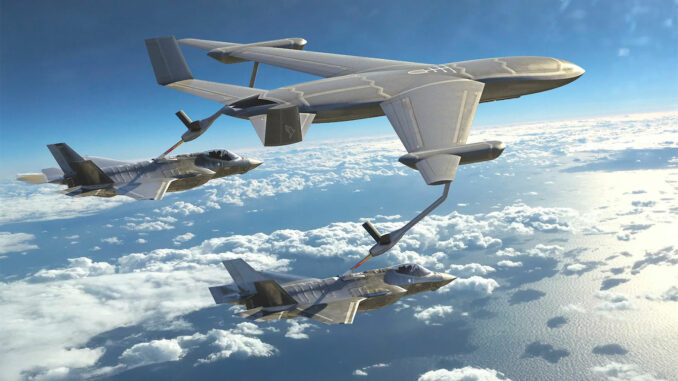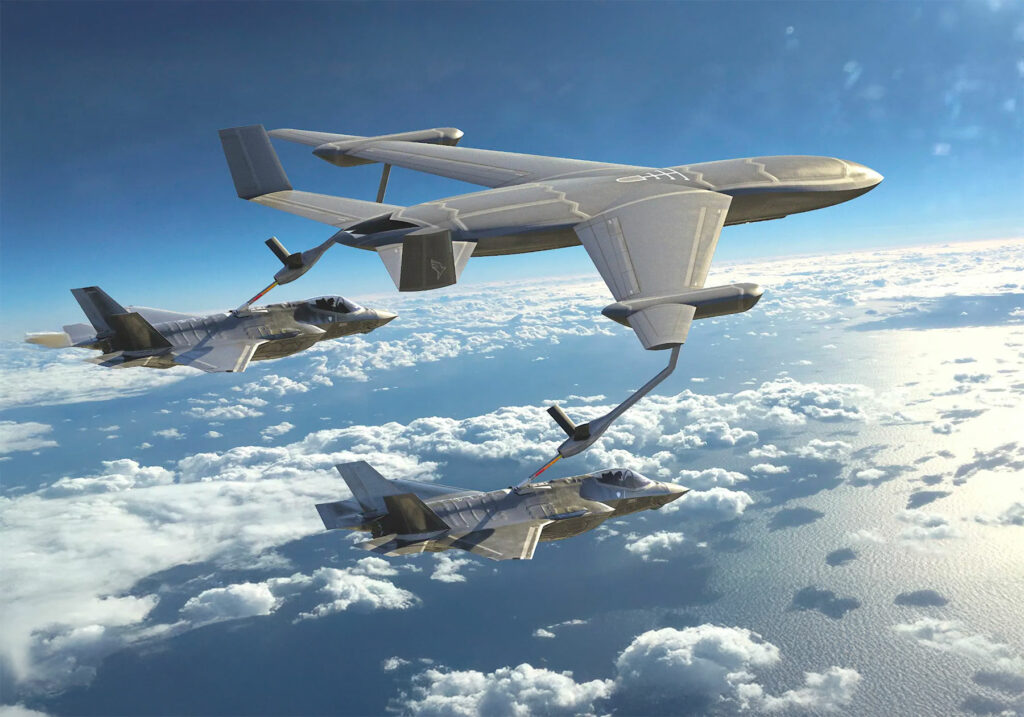
Lockheed Martin Skunk Works proposes a stealth tanker for the USAF, combining versatility and stealth for the Next Generation Air Dominance system.
Lockheed Martin, via its Skunk Works division, is proposing a stealth tanker concept designed to meet the needs of the US Air Force’s (USAF) Next Generation Air Dominance (NGAD). The tanker would be stealthy, with optional piloting capability and equipped with boom and probe refueling systems. The project is designed to provide long-range air support, reducing vulnerability to modern threats. The design is optimized for radar stealth, a strategic asset in the face of growing threats such as those posed by China.
Background and challenges of the stealth tanker
The development of a stealth tanker is motivated by the need to meet modern threats and support the missions of fifth- and sixth-generation fighter jets. China’s growing power and the increasing sophistication of its air defense systems mean that the refueling strategy of US air forces needs to be reviewed. Conventional tanker aircraft such as the KC-46 and KC-135 are vulnerable when operating close to high-threat zones. The NGAD, an initiative that includes stealth fighters and collaborative UAVs, requires refueling solutions that are able to stay in close proximity to threats without being easily detected.
The stealth design of the Skunk Works tanker features specific characteristics to reduce its radar signature, such as outwardly inclined vertical stabilizers and a low-observability skin. The configuration is designed for refueling flexibility: it can use a boom system for USAF aircraft, or the probe system for Navy and Marine aircraft. The costs associated with this stealth technology, while improving tanker safety, represent a considerable budgetary challenge for US defense.
Optimized design for stealth and performance
The Skunk Works concept includes advanced design elements to ensure optimum stealth. These include a chamfered line around the front fuselage and saw-tooth panels, features known to reduce radar signature. In addition, a unique “duckbill” exhaust is incorporated, helping to minimize thermal detection, a crucial factor in the face of modern radar.
These features, combined with the swept wings and specially oriented horizontal and vertical stabilizers, contribute to the reduction of infrared and electromagnetic signals emitted by the aircraft. The aircraft’s design therefore appears to be optimized for stealth while retaining energy efficiency, which is essential for long-duration missions. However, the technologies implemented require significant research and development costs, often estimated at several billion dollars, as observed in other Lockheed Martin stealth programs.

Operational flexibility: a tanker with or without a pilot
A notable feature of the tanker proposed by Skunk Works is its optional pilot capability. This concept offers greater flexibility: it can be piloted for missions in airspace requiring human supervision, or operated remotely for autonomous missions. This hybrid capability could accelerate operational testing, with the presence of a pilot to manage complex missions, while the autonomous mode would be suitable for safer environments.
Fully autonomous tankers, while effective, face restrictions in certain airspaces and regulatory constraints. The presence of a pilot offers the advantage of circumventing these limitations and enabling the tanker to participate in complex military exercises, thus facilitating its integration into existing fleets. This type of pilotable but autonomous design combines the advantages of stealth and autonomy, while guaranteeing human intervention if necessary.
Economic and industrial consequences
The cost of developing this stealth tanker is one of the main challenges of the project. According to estimates for similar programs, a development of this scale could cost between 5 and 10 billion euros, including research, testing and necessary adjustments. By comparison, the KC-46 Pegasus program has already cost around 5.7 billion euros. However, this type of investment can be justified by the strategic advantages it brings in the face of growing threats.
The impact on the defense sector is also significant. This type of tanker could position Lockheed Martin and its partners as leaders in stealth technologies for air-to-air refueling, a niche that is currently little exploited. If the USAF decides to launch mass production, it could also foster collaborations with other allied countries, which might be interested in similar capabilities for their own fleets.
Strategic perspectives and future developments
The stealth design of this tanker could play a key role in future air warfare doctrines. In potential conflict zones such as the Asia-Pacific, the ability to refuel combat aircraft discreetly outside the range of enemy radars represents a major asset. This tanker could enable fighter jets to maintain a prolonged presence without risking compromising the positions of allied forces.
As air defense systems continue to evolve, a stealth tanker could also reduce the cost of the combat platforms themselves, by limiting their need for autonomy. For example, 6th generation fighters integrated into the NGAD program could make do with a more limited autonomy if stealth tankers like the one from Skunk Works are available close to combat zones, enabling substantial savings on the design of these fighters.
War Wings Daily is an independant magazine.